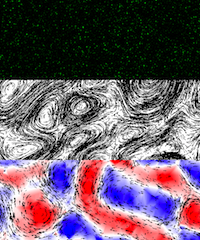Research
Lagrangian Particle Tracking

Our primary measurement tool is optical Lagrangian Particle Tracking (LPT). The basic idea of this technique is to follow the motion of solid particles added to the flow that behave the same as a true fluid element. For this approximation to hold, the particles must be very small (compared with the smallest dynamical flow scales) and of the same density as the carrier fluid. If these assumptions are not met, the particles may move differently from the fluid.
In turbulence, particles move both rapidly and erratically. We therefore need to image them at extremely high frame rates in order to follow their motion accurately, and especially to be able to compute Lagrangian velocities and accelerations from the particle trajectories. We use high-speed digital cameras to take images of the particles tens of thousands of times every second. With such short exposure times, we use high-power lasers to illuminate the particles. This process produces data at a rate of up to several gigabytes per second!
We use multiple cameras to image the particles from a variety of views simultaneously. With this redundant information, we can then reconstruct the positions of each particle in 3D. We use in-house software (developed in C++) to generate trajectories from the raw particle positions with a multiframe predictive algorithm. We have recently parallelized our tracking software, and can now use it to track up to 50,000 particles per 2D image! A simple-to-use version of our 2D tracking software is available for download on our software page.

When the particles are close together and sample the domain densely, we can spatially interpolate between them to determine the full velocity field and its gradients, in what is often termed Particle Tracking Velocimetry (PTV). We have developed software tools to optimize these fields, making them smooth without introducing unknown spectral effects.
Finally, note that particle tracking is a very generic tool, and need not only be applied to fluids. In principle, our software will allow us to track any erraticly moving small "particles"---including cells or insects!
Representative Publications
N. T. Ouellette, H. Xu, and E. Bodenschatz, "A quantitative study of three-dimensional Lagrangian particle tracking algorithms," Exp. Fluids 40, 301-313 (2006).
N. T. Ouellette, H. Xu, and E. Bodenschatz, "Measuring Lagrangian statistics in intense turbulence," in Springer Handbook of Experimental Fluid Dynamics, ed. C. Tropea, A. L. Yarin, and J. F. Foss, pp. 789-799 (Springer-Verlag, Berlin, 2007).
N. T. Ouellette, "Particle-based measurement techniques for soft matter," in Experimental and Computational Techniques in Soft Condensed Matter Physics, ed. J. Olafsen, pp. 180-208 (Cambridge University Press, Cambridge, 2010).
D. H. Kelley and N. T. Ouellette, "Using particle tracking to measure flow instabilities in an undergraduate laboratory experiment," Am. J. Phys. 79, 267-273 (2011).
D. H. Kelley and N. T. ouellette, "Onset of three-dimensionality in electromagnetically forced thin-layer flows," Phys. Fluids 23, 045103 (2011).